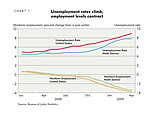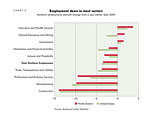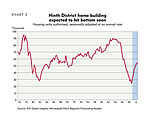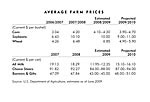The Ninth District economy has followed the U.S. economy into a relatively deep and protracted recession. While there are signs that the pace of contraction is slowing and that hitting bottom is likely yet in 2009, the ensuing recovery is expected to be modest, according to the Minneapolis Fed's forecasting models.
Employment levels have fallen sharply in most areas of the district, and the contraction in jobs is expected to persist into 2010. However, after decreasing in 2009, income levels are expected to pick up in 2010, a sign that overall economic growth will turn positive not too far into the future. The manufacturing sector continues to contract, but at a slower pace, and construction remains soft. Meanwhile, after a positive year overall in 2008, district farmers are expecting an average performance in 2009.
District employment falls
The U.S. economy decreased 6.3 percent and 5.7 percent in the past fourth and first quarters, respectively. These are the two deepest consecutive quarters of contraction since the fourth quarter of 1981 and the first quarter of 1982. Furthermore, the current recession is the longest since World War II. The U.S. unemployment rate increased from 4.9 percent in December 2007 to 9.4 percent in May. Most of the increase occurred after September 2008.
The Ninth District economy also slowed sharply during the past fourth and first quarters. Unemployment rates increased, and year-over-year changes in employment dropped during this period (see Chart 1). However, the western states of Montana and the Dakotas performed better than the eastern states of Minnesota, Wisconsin and the Upper Peninsula of Michigan.
As of April, district employment levels were down 3.4 percentage points compared with a year ago, slightly better than the national average (see Chart 2). Sectors that shed the largest percentage of jobs include construction (-13.7 percent), manufacturing (-9.8 percent), professional business services (-9.4 percent) and trade, transportation and utilities (-3.6 percent). Sectors that showed an increase in jobs include education and health services (+3.6 percent), natural resources and mining (+1.7 percent) and government (+1.4 percent).
The Minneapolis Fed's forecasting models show that unemployment rates are expected to increase through 2009, while employment levels are expected to drop. In 2010, unemployment rate increases and employment decreases are predicted to moderate. (See Economic Forecasts.)
Signs of modest recovery
While the seeds of the current recession were sown by difficulties in housing markets and the financial sector, declines in net hiring, consumer spending and manufacturing dragged the economy further downward during the fourth and first quarters. But even though a number of indicators show the economy has moved into a deep recession, these indicators also point toward improving conditions.
Nationally, personal consumption expenditures decreased during the second half of 2008 by an annual rate of about 4 percent, the deepest decrease in consumer spending since 1980. Consumer spending represents over 70 percent of the U.S. economy. However, consumer spending turned positive during the first two months of 2009. While declining slightly in March and April, consumer spending is no longer contracting as deeply as it did in the second half of 2008.
As consumer spending decreased, consumers started saving more. Personal savings as a percentage of disposable personal income averaged only 0.7 percent from 2005 through third quarter 2008. During fourth quarter 2008 and first quarter 2009, the savings rate increased to 3.2 percent and 4.4 percent, respectively. The savings rate in first quarter 2009 was the highest since 1998. While lower equity and housing prices have diminished household wealth, the higher savings rate suggests that households have taken steps to shore up their financial position, and if this is the case, savings will help facilitate more consistent economic growth going forward.
Consumers are also facing relatively tame price pressures. According to the Bureau of Labor Statistics, the core inflation rate, which excludes volatile food and energy prices, remained below 2 percent on a year-over-year basis during the first few months of 2009.
Meanwhile, recent wholesale price lev-els were lower than a year ago. However, gasoline prices are up over 40 percent since the beginning of the year.
According to the Minneapolis Fed's forecasting models, personal income in district states is expected to finish flat or fall somewhat by the end of 2009. Constraints on personal income will likely contribute to modest consumer spending levels in the district for the rest of the year. However, by 2010 personal income is expected to grow, which would help consumer spending pick up.
Meanwhile, manufacturing levels nationally have contracted consistently since the beginning of 2008. According to the Institute for Supply Management survey of purchasing managers, through May the manufacturing sector contracted for 16 consecutive months. However, the May survey pointed to an improving trend since December 2008, when manufacturing activity hit a low point.
A separate survey on business conditions by Creighton University found that manufacturing activity in Minnesota from December 2007 through May 2008 contracted for all but two months. But like the ISM national survey, Minnesota's performance in the Creighton survey points to less dire conditions. Manufacturing activity in North Dakota and South Dakota also contracted through May, but only turned negative in those states beginning five months and seven months earlier, respectively.
Housing sector nearing bottom
The downturn in home building began in 2005, when housing units authorized started to decrease, and ultimately declined by 67 percent through first quarter 2009. This drop is the largest decline since the late 1970s and early 1980s, when housing units authorized decreased 71 percent from 1978 to 1982 (see Chart 3).
The silver lining for the current situation is that the fall in home building can only go so far. The question is whether the recovery in the home building sector will pick up relatively quickly as it did after dropping so precipitously in the late 1970s, or if the recovery will be slower. The Minneapolis Fed's forecasting models point to a relatively quick recovery once the bottom is reached during 2009.
In order for the home building sector to recover, demand for houses must pick up. National measures of new home sales are at very low levels. New home sales in April were down 34 percent compared with a year ago. In the district, sales of existing homes were lower than last year in most states during the first quarter of 2009, except in Minnesota, where sales increased 11 percent. Activity was particularly strong in distressed sales, including sales of foreclosed homes. However, real estate agents in the Minneapolis-St. Paul area reported in May that regular home sales were starting to pick up, a trend home builders hope will continue.
An average year for agriculture in 2009
District farmers fared well in 2008, but dairy and cattle producers saw some problems. The first half of 2009 brought low dairy prices and severe weather. The calving season went poorly in the western portion of the district. Wet weather delayed planting in North Dakota. Dry weather in eastern Minnesota and western Wisconsin has farmers worried. Meanwhile, several ethanol producers have changed ownership and some have ceased production, which has affected corn producers. After a roller coaster year for prices in 2008, the outlook is for greater stability.
The Minneapolis Fed surveys agricultural lenders every quarter to get their views on how customers are faring financially. Results from the 2008 surveys were generally positive. However, the first-quarter (April 2009) agricultural credit conditions survey results indicate that the start of the year was very disappointing for agricultural income, with 58 percent of survey respondents reporting decreased income. Agricultural lenders were pessimistic for farm profits in the second quarter of 2009, with 55 percent expecting decreased income and only 6 percent expecting increased income. (See Agricultural Credit Conditions.)
Farmers and ranchers were battered by Mother Nature at the start of 2009. Several blizzards in the western portion of the district hammered calves, and the loss rate was higher than average in many areas. Extremely wet soil hampered planting in the Dakotas, and these delays caused some farmers to switch from corn to soybeans. Meanwhile, drought conditions developed in southeastern Minnesota and western Wisconsin.
For farmers, the outlook is for stable prices. Corn and soybean prices are expected to hover in the same range from 2008 into 2009 and even into 2010 (see table). However, wheat prices are expected to fall in the next marketing cycle. Farm revenues overall will probably be more affected by yields. The spring weather disruptions could have a negative effect on the fall harvest. Even with the possibility of decreased revenues, profits could be average, as the prices for many inputs have fallen from their peaks in 2008.
Many ethanol producers went bankrupt over the past two years. This has caused some hardship on farmer-owners as well as on farmers whose contracts were not honored. Many of the ethanol plants that have gone through bankruptcy have new owners and are still running and consuming corn, but a few have been shuttered.
For animal and dairy producers, the outlook is not as optimistic. Profits are squeezed by flat to lower selling prices and disrupted operations. Input costs have stabilized, but milk prices have dropped significantly in 2009. They are expected to rebound somewhat in 2010. Cattle prices dropped significantly in 2009 and are expected to edge up in 2010. Hog prices are estimated to dip slightly in 2009 and increase to higher levels in 2010.











